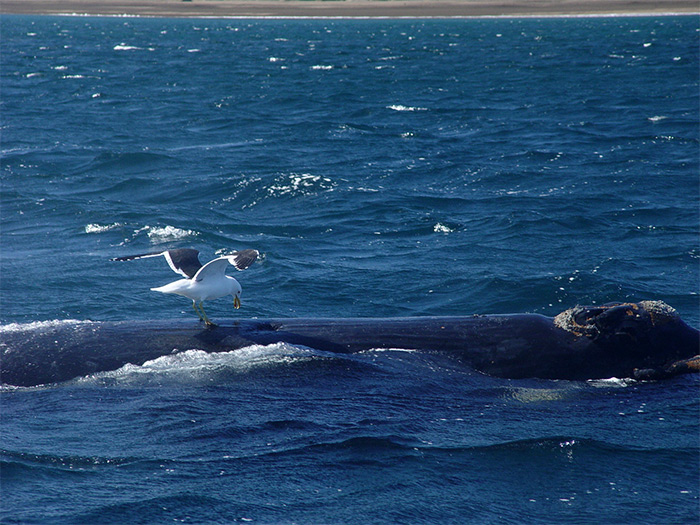Kelp Gulls causing whale deaths face cull
At least 626 southern right whale (Eubalaena australis) calves died at the Península Valdés calving ground, Argentina, between 2003 and 2014. Intense gull harassment may have contributed to these deaths.

In the 1970s, Kelp Gulls (Larus dominicanus) began feeding on skin and blubber pecked from the backs of living right whales at Valdés. The frequency of gull attacks has increased dramatically over the last three decades and mother-calf pairs are the primary targets.
Pairs attacked by gulls spend less time nursing, resting and playing than pairs not under attack. In successive attacks, gulls open new lesions on the whales’ backs or enlarge pre-existing ones. Increased wounding could potentially lead to dehydration, impaired thermoregulation, and energy loss to wound healing.
The presence, number and total area of gull-inflicted lesions were assessed using aerial survey photographs of living mother-calf pairs in 1974–2011 and stranding photographs of dead calves in 2003–2011. The percentage of living mothers and calves with gull lesions increased from an average of 2% in the 1970s to 99% in the 2000s.
In the 1980s and 1990s, mothers and calves had roughly equal numbers of lesions (one to five), but by the 2000s, calves had more lesions (nine or more) covering a greater area of their backs compared to their mothers.
Mothers appear to have learned how to defend themselves. The lack of change in number and area of lesions on mothers may be explained by their adopting a variety of resting and breathing postures that help them evade gull attacks. Until the late 1980s, mothers were often seen resting at the surface (even for an hour or more) and their backs dried out exposing peeling skin that was pecked off by Kelp Gulls. However, since the mid-1990s, mothers with dry backs are rarely seen because they have adopted avoidance postures such as the "galleon". In the galleon posture mothers arch their backs exposing only their heads and tail flukes above water. The galleon posture was first documented in 1984 and has spread through the adult population.
Unlike mothers, calves have not developed as many avoidance postures and may be more vulnerable to gull attacks. They have shorter backs (compared to adults and juveniles) and may therefore find it difficult to arch their bodies deeply enough below the surface. Perhaps more fundamentally, calves have never experienced Kelp-Gull attacks, while their mothers have had many seasons on the Valdés calving ground to learn about them. Calves surface to breathe much more frequently than adults, so they are exposed more often than older whales. Since the 2000s, some calves (and also mothers) have learned to surface at an oblique angle to blow while keeping their backs under water (“oblique breathing”). Oblique breathing may minimize the impact of gull attacks but could also be energetically costly for newborns or young calves. Thus avoiding gull attacks seems likely to be more energetically costly for calves (e.g., swimming away at fast speeds, or performing oblique breathing) than for mothers, in a period when most of their energy is needed for growth, development and play.
Since the 1990s, mothers have learned to evade gull attacks but calves have not, and the numbers and sizes of lesions on calves have continued to increase. Kelp Gull harassment has clearly become a significant threat to the health and welfare of the Península Valdés right whale population. How best to mitigate that threat is not obvious, but a project to cull the Kelp Gull population at Valdés was initiated in 2012 by the provincial government of Chubut in collaboration with researchers from Centro Nacional Patagónico (CENPAT-CONICET). Continuing the long-term data series that were used here will greatly facilitate efforts to evaluate the effectiveness of this culling.
24 November 2015
Source: Marón C F, Beltramino L & 6 others. 2015. Increased Wounding of Southern Right Whale (Eubalaena australis) Calves by Kelp Gulls (Larus dominicanus) at Península Valdés, Argentina. PLoS ONE 10: e0142969. doi: 10.1371/journal.pone.0142969





